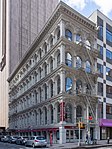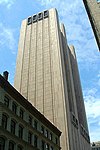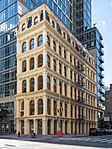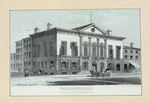David S. Brown Store
Commercial buildings completed in 1875Commercial buildings on the National Register of Historic Places in ManhattanGothic Revival architecture in New York (state)Manhattan Registered Historic Place stubsNew York City Designated Landmarks in Manhattan ... and 1 more
Tribeca

The David S. Brown Store at 8 Thomas Street between Broadway and Church Street in the TriBeCa neighborhood of Manhattan, New York City was built in 1875-76 for a soap manufacturer. It was designed by J. Morgan Slade in the Victorian Gothic style, as influenced by John Ruskin and French architectural theory. The building has been called "An elaborate confection of Romanesque, Venetian Gothic, brick, sandstone, granite, and cast-iron parts..."The building was designated a New York City landmark in 1978, and was added to the National Register of Historic Places in 1980.
Excerpt from the Wikipedia article David S. Brown Store (License: CC BY-SA 3.0, Authors, Images).David S. Brown Store
New York Manhattan
Geographical coordinates (GPS) Address Nearby Places Show on map
Geographical coordinates (GPS)
| Latitude | Longitude |
|---|---|
| N 40.715833333333 ° | E -74.006111111111 ° |
Address
New York, Manhattan
New York, United States
Open on Google Maps










